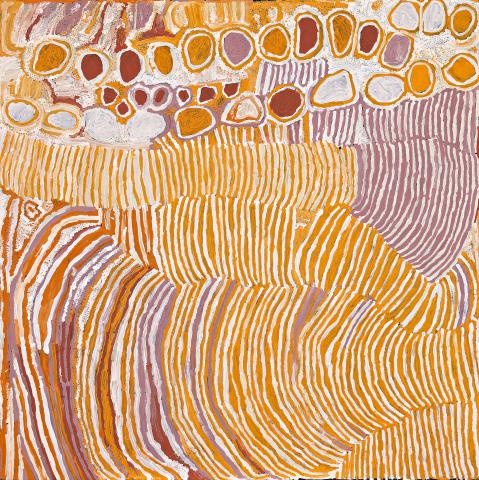KUNGKA KUTJARRA (TWO WOMEN), 2000
MAKINTI NAPANANGKA
synthetic polymer paint on linen
122.0 x 122.0 cm
bears inscription verso: artist’s name, size and Papunya Tula Artists cat. MN0009077
Papunya Tula Artists, Alice Springs
Utopia Art, Sydney (label attached verso)
The Collection of Colin and Elizabeth Laverty, Sydney, acquired from the above in December 2001
Makinti Napanangka: New Paintings, Utopia Art, Sydney, 10 November – 5 December 2001 (label attached verso)
Paintings from Remote Communities: Indigenous Australian Art from the Laverty Collection, Sydney, Govett Brewster Art Gallery, New Plymouth, New Zealand, 15 December 2007 – 24 February 2008; then touring to: Newcastle Region Art Gallery, New South Wales, 5 July – 31 August 2008
Breaking with tradition: Cobra and Aboriginal art, AAMU – Museum of Contemporary Aboriginal Art, Utrecht, The Netherlands, 12 November 2010 – 8 May 2011 (illus. in exhibition catalogue)
Laverty. C., ‘Diversity and Strength: Contemporary Australian Aboriginal Art – A Private Collection’, Arts of Asia, Hong Kong, November – December 2013, cat. 9, p. 86
Beyond Sacred: Recent Painting from Australia’s Remote Aboriginal Communities: The Collection of Colin and Elizabeth Laverty, Hardie Grant Books, Melbourne, 2008, p. 77 (illus.)
Beyond Sacred: Recent Painting from Australia’s Remote Aboriginal Communities: The Collection of Colin and Elizabeth Laverty, edition II, Kleimeyer Industries Pty Ltd, Melbourne, 2011, p. 66 (illus.)
This work is accompanied by a certificate of authenticity from Papunya Tula Artists, Alice Springs
‘Light flooded.’ This is how Vivien Johnson described Makinti Napanangka’s first paintings after she had cataracts removed from her eyes in 1999.1 Makinti had initially commenced painting in 1994 at Haasts Bluff and she was among the small group of female artists who participated in the Minyma Tjukurrpa, Kintore/Haasts Bluff canvas project in 1995, an exhibition that heralded the beginnings of the women’s painting movement through Papunya Tula Artists cooperative.2 But she came into her own in 2000 with her first solo exhibition at Utopia Art Sydney, aptly entitled New Vision, an allusion to her restored eyesight, but also perhaps to the freshness of a body of paintings radiant with golden light. The Sydney Olympic year also saw her inclusion in the benchmark exhibition Papunya Tula: Genesis and Genius at the Art Gallery of New South Wales with a painting of the same subject from the same year.
In Kungka Kutjarra (Two Women), 2000, Makinti Napanangka combines graphic motifs that dominated her earlier paintings–series of outlined circular forms, here denoting rockholes – with the bands of parallel arcs that became the hallmark of her later work. The rockholes were formed by Kungka Kutjarra, two ancestral women, at a site south of Lake MacDonald while digging for Kuningka, the Western Quoll. The bands represent the strands of spun hair string that make up the nyimparra or skirts worn by women in ceremony. The tactility of the paint in this picture suggests the practice of drawing in the sand to a narrative accompaniment, and the rhythms of the bands of arcs echo the sway of the skirts as women dance.
1. Johnson, V., Lives of the Papunya Tula Artists, IAD Press, Alice Springs, 2008, p. 316
2. Exhibited at Tandanya National Aboriginal Cultural Institute, Adelaide
WALLY CARUANA
